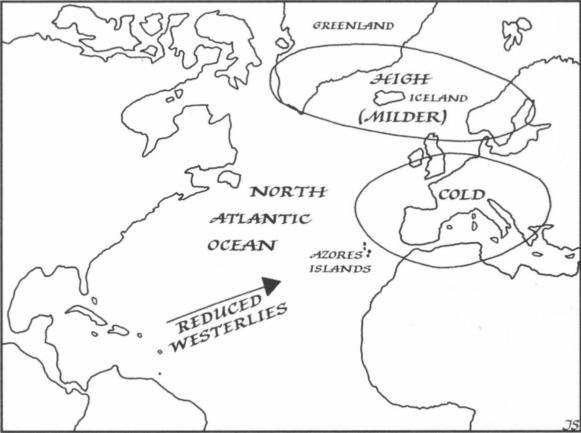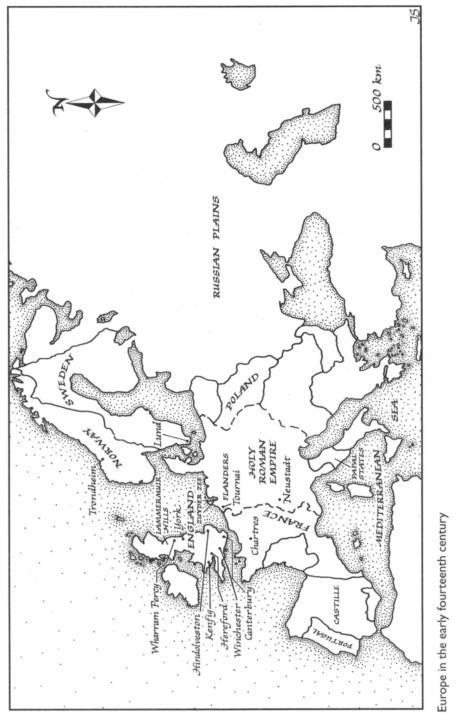The Little Ice Age: How Climate Made History 1300-1850 (8 page)
Read The Little Ice Age: How Climate Made History 1300-1850 Online
Authors: Brian Fagan

The chaotic atmosphere over the North Atlantic plays a major role in
the NAO's unpredictable behavior. So do the mild waters of the Gulf
Stream, which flow northeast off North America and then become the
North Atlantic current, bringing warm water to the British Isles and adjacent coasts as far north as Iceland and Norway. The warmer surface waters
of the north flush regularly, sinking toward the bottom, carrying atmospheric gases and excess salt. Two major downwelling sites are known, one
just north of Iceland, the other in the Labrador Sea southwest of Greenland. At both these locations, vast quantities of heavier, salt-laden water
sink far below the surface. Deep subsurface currents then carry the salt southward. So much salt sinks in the northern seas that a vast heat pump
forms, caused by the constant influx of warmer water, which heats the
ocean as much as 30 percent beyond the warmth provided by direct sunlight in the north. What happens if the flushing fails? The pump slows
down, the warm North Atlantic current weakens, and temperatures fall
rapidly in northwestern Europe. When downwelling resumes, the current
accelerates and temperatures climb again. The effect is like a switch, triggered by the interaction of atmosphere and ocean. For example, in the
early 1990s, the Labrador Sea experienced vigorous downwelling, which
gave Europe mild winters. In 1995/96, the NAO index changed abruptly
from high to low, bringing a cold winter in its wake.

Greenland above effect
The NAO has affected European climate for thousands of years. By
piecing together information from tree rings, ice cores, historical records,
and modern-day meteorological observations we now have a record of the
North Atlantic Oscillation going back to at least 1675. Low NAO indices
seem to coincide with known cold snaps in the late seventeenth century.
Over the past two centuries, NAO extremes have produced memorable
weather like the very cold winters of Victorian England in the 1880s. An other low index cycle in the 1940s enveloped Europe in savage cold as
Hitler invaded Russia. The 1950s were somewhat kinder, but the 1960s
brought the coldest winters since the 1880s. Over the past quartercentury, high NAO indices have brought the most pronounced anomalies
ever recorded and warmed the Northern Hemisphere significantly, perhaps as a result of humanly caused global warming.
For many centuries, Europe's weather has been at the mercy of capricious swings of the NAO Index and of downwelling changes in the Arctic. We do not know what causes high and low indices, nor can we yet
predict the sudden reversals that trigger traumatic extremes. But we can
be certain that the NAO was a major player in the unpredictable, often
extremely cold, highly varied weather that descended on Europe after
1300.

In the thirteenth century, Greenland and Iceland experienced increasing
cold. Sea ice spread southward around Greenland and in the northernmost Atlantic, creating difficulties for Norse ships sailing from Iceland as
early as 1203. Unusual cold brought early frosts and crop failures to
Poland and the Russian plains in 1215, when famine caused people to sell
their children and eat pine bark. During the thirteenth century, some
Alpine glaciers advanced for the first time in centuries, destroying irrigation channels in high mountain valleys and overrunning larch forests.
While colder temperatures afflicted the north, Europe as a whole benefited from the change. The downturn of temperatures in the Arctic
caused a persistent trough of low pressure over Greenland and enduring
ridges of high pressure over northwestern Europe. A period of unusually
warm, mostly dry summers between 1284 and 1311, in which May frosts
were virtually unknown, encouraged many farmers to experiment with
vineyards in England. After the turn of the fourteenth century, however,
the weather turned unpredictable.
The year 1309/10 may have been a "Greenland above" year. The dry
and exceptionally cold winter made the Thames ice over and disrupted
shipping from the Baltic Sea to the English Channel. An anonymous
chronicler wrote,
In the same year at the feast of the Lord's Nativity, a great frost and ice was
massed together in the Thames and elsewhere, so that poor people were
oppressed by the frost, and bread wrapped in straw or other covering was
frozen and could not be eaten unless it was warmed: and such masses of
encrusted ice were on the Thames that men took their way thereon from
Greenhithe in Southark, and from Westminster, into London; and it lasted
so long that the people indulged in dancing in the midst of it near a certain fire made on the same, and hunted a hare with dogs in the midst of
the Thames.I
By 1312, the NAO Index was high, the Atlantic storm track shifted southward, and winters were mild again. Three years later, the rains began in
earnest.
The deluge began in 1315, seven weeks after Easter. "During this season [spring 1315] it rained most marvellously and for so long," wrote a
contemporary observer, Jean Desnouelles. Across northern Europe,
sheets of rain spread in waves over the sodden countryside, dripping
from thatched eaves, flowing in endless rivulets down muddy country
lanes. Wrote chronicler Bernardo Guidonis: "Exceedingly great rains descended from the heavens, and they made huge and deep mud-pools on
the land." Freshly plowed fields turned into shallow lakes. City streets
and narrow alleys became jostling, slippery quagmires. June passed, then
July with little break in the weather. Only occasionally did a watery sun
break through the clouds, before the rain started again. "Throughout
nearly all of May, July, and August, the rains did not cease," complained
one writer.z An unseasonably cold August became an equally chilly September. Such corn and oats as survived were beaten down to the ground,
heavy with moisture, the ears still soft and unripened. Hay lay flat in the
fields. Oxen stood knee deep in thick mud under sheltering trees, their
heads turned away from the rain. Dykes were washed away, royal manors
inundated. In central Europe, floods swept away entire villages, drowning hundreds at a time. Deep erosion gullies tore through hillside fields
where shallow clay soils could not absorb the endless water. Harvests had
been less than usual in previous years, causing prices to rise, but that of
1315 was a disaster. The author of the Chronicle of Malmesbury wondered, like many others, if divine vengeance had come upon the land:
"Therefore is the anger of the Lord kindled against his people, and he hash stretched forth his hand against them, and hath smitten them."3
Tree rings from northern Ireland show that 1315 was a year of extraordinary growth for oak trees.

Europe was a continent of constant turmoil and minor wars, of endless
killings, raids, and military expeditions. Many conflicts stemmed from
succession disputes and personal rivalries, from sheer greed and reckless
ambition. The wars continued whatever the weather, in blazing sunshine
or torrential rain, armies feeding off villages, leaving empty granaries and
despoiled crops in their train. War merely increased the suffering of the
peasants, who lived close enough to the edge as it was. But the rains of
1315 stopped military campaigning in its tracks.
Trade and geography made Flanders one of the leading commercial
centers of fourteenth-century Europe. Italian merchant bankers and
moneylenders made their northern headquarters here, attracted by the
great wealth of the Flemish weaving industry. Technically a fief of France,
the country and its prosperous towns were more closely tied to England,
whose wool formed the cloth woven across the North Sea. The quality
and fine colors of Flemish fabrics were prized throughout Europe and as
far afield as Constantinople, creating prosperity but a volatile political situation. Both England and France vied for control of the region. While
the Flemish nobility kept French political interests and cultural ties dominant, the merchants and working classes favored England out of self-interest. In 1302, Flemish workers had risen in rebellion against their
wealthy masters. The flower of French knighthood, riding north to crush
the rebellion, had fallen victim to the swampy terrain, crisscrossed with
canals, where bowmen and pikemen could pick off horsemen like helpless fish. Seven hundred knights perished in the Battle of Courtai and the
defeat was not avenged for a quarter-century. The inevitable retaliation
might have come much earlier had not the rain of 1315 intervened.
In early August of that year, French king Louis X planned a military
campaign into Flanders, to isolate the rebellious Flemings from their
North Sea ports and lucrative export trade. His invasion force was poised
at the border before the Flemish army, ready to advance in the heavy rain.
But as the French cavalry trotted onto the saturated plain, their horses
sank into the ground up to their saddle girths. Wagons bogged down in
the mire so deeply that even seven horses could not move them. The infantry stood knee-deep in boggy fields and shivered in their rain-flooded tents. Food ran short, so Louis X retreated ignominiously. The thankful
Flemings wondered if the floods were a divine miracle. Their thankfulness did not last long, for famine soon proved more deadly than the
French.
The catastrophic rains affected an enormous area of northern Europe,
from Ireland to Germany and north into Scandinavia. Incessant rain
drenched farmlands long cleared of woods or reclaimed from marsh by
countless small villages. The farmers had plowed heavy soils with long
furrows, creating fields that absorbed many millimeters of rain without
serious drainage problems. Now they became muddy wildernesses, the
crops flattened where they grew. Clayey subsoils became so waterlogged
in many areas that the fertility of the topsoil was reduced drastically for
years afterward.
As rural populations grew during the thirteenth century, many communities had moved onto lighter, often sandy soils, more marginal farming land that was incapable of absorbing sustained rainfall. Deep erosion
gullies channeled running water through ravaged fields, leaving little
more than patches of cultivable land. In parts of southern Yorkshire in
northern England, thousands of acres of arable land lost their thin topsoil
to deep gullies, leaving the underlying rock exposed. As much as half the
arable land vanished in some places. Inevitably, crop yields plummeted.
Such grain as could be harvested was soft and had to be dried before it
could be ground into flour. The cold weather and torrential rains of late
summer 1315 prevented thousands of hectares of cereals from ripening
fully. Fall plantings of wheat and rye failed completely. Hay could not be
cured properly.
Hunger began within months. "There began a dearness of wheat.
... From day to day the price increased," lamented a chronicler in Flanders.4 By Christmas 1315, many communities throughout northwestern
Europe were already desperate.
Few people understood how extensive the famine was until pilgrims,
traders, and government messengers brought tales of similar misfortune
from all parts. "The whole world was troubled," wrote a chronicler at
Salzburg, which lay at the southern margins of the affected region.5 King
Edward II of England attempted to impose price controls on livestock,
but without success. After the hunger grew worse, he tried again, placing
restrictions on the manufacture of ale and other products made from grain. The king urged his bishops to exhort hoarders to offer their surplus
grain for sale "with efficacious words" and also offered incentives for the
importation of grain. At a time when no one had enough to eat, none of
these measures worked.
